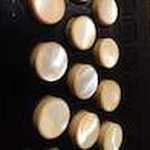The two row or two and a half row is the bread and butter of DBAs. These are effectively two one rows bolted together. Each row is in it’s own key and these two keys will be 4 notes apart. Any of these will make a great starter box, any tune played on one of these can be played on all of the others by pushing the exact same buttons (The complicated word for this is transposing)
Two Row Keys
Below are the common fourth apart (sometimes called quint apart) musical key combinations, the first key listed is the outside row
Music theory is deep and i don’t have the time or skill to explain it all. Each major key consists of 7 notes in a rising scale (an octave). Confusingly they start at C, and then go D G E F G A B . you don’t need to understand any of it to bang out a tune, suffice to say that all of the keys listed are major keys
- G/C . The lowest in tone popular for French tunes. Tunes in this key tend to be played at the higher end of the keyboard.
- A/D . An uncommon key but you get a great growly sound out of them.
- Bb/Eb . A good low box to play, and transposed tunes sound great on these. An alternative to the more popular C/F . Club accordions were made in this key combination as well
- C/F . A good pitch to sing along with , again this was a very common key in Germany. The majority of Club accordions were made in this key combination as well. This is a really nice key which avoids some of the squeakyness you get with the D/G. A good box for playing at home.
- D/G . The highest common combination but this is the most commonly used key combination for English traditional folk music. If you want to play along with other people in the UK this is the one you want
These are most commonly available in a 2 row 8 bass combination the most common of which is the venerable Pokerwork (more correctly the Wiener 2915) . They come in many more complicated versions but this is the benchmark. Many modern boxes will have 12 or more basses and the number of treble keys typically varies between 19 and 30
The Half Row
Some two rows will have an additional half row of buttons closest to the bellows, these go from a row of 2 to 7 extra buttons, these are accidentals and reversals
Accidentals
An accidental is simply a note which is not in a specified key so these are sharps and flats in the main.
Reversals
Due to the way that the keyboard is laid out and the fact that the push and pull order changes half way up the keyboard (honestly this does make sense) most notes are available as a push on one of the rows and as a pull on the other. However a few aren’t so these will often appear in the half row to smooth things out.
Transposing
This where you play a tune written in one key in a different key. For the sake of a simple tune the thing to remember is that regardless what key a DBA is in, if you push the same buttons the same tune will come out, just a bit higher or lower than the original key. If you learn a tune on a D/G box you can pick up a box in any key and by pressing the keys in the same order the same tune will come out, just a bit lower.
One row diatonic button Accordion or Melodeon (e.g Hohner HA114 . including cajun quebecois etc)
- Two row Diatonic Button Accordion or Melodeon (e.g Hohner Pokerwork including 2 1/2 row)
- Club Accordion (eg Hohner Cub IIB)
- Three row Diatonic Button Accordion (e.g Hohner Corona)
- Two row Chromatic Button Accordion (e.g Hohner Double Ray small)
- Chromatic Button Accordion (full size)

